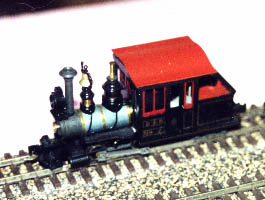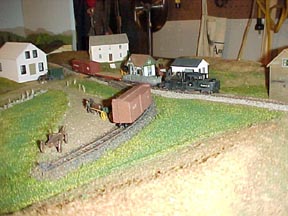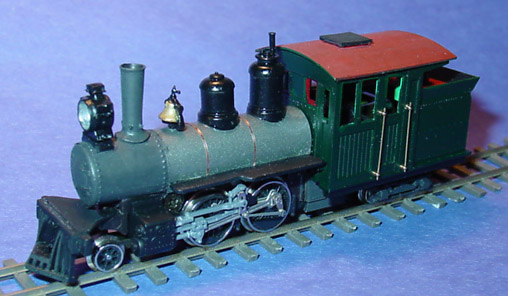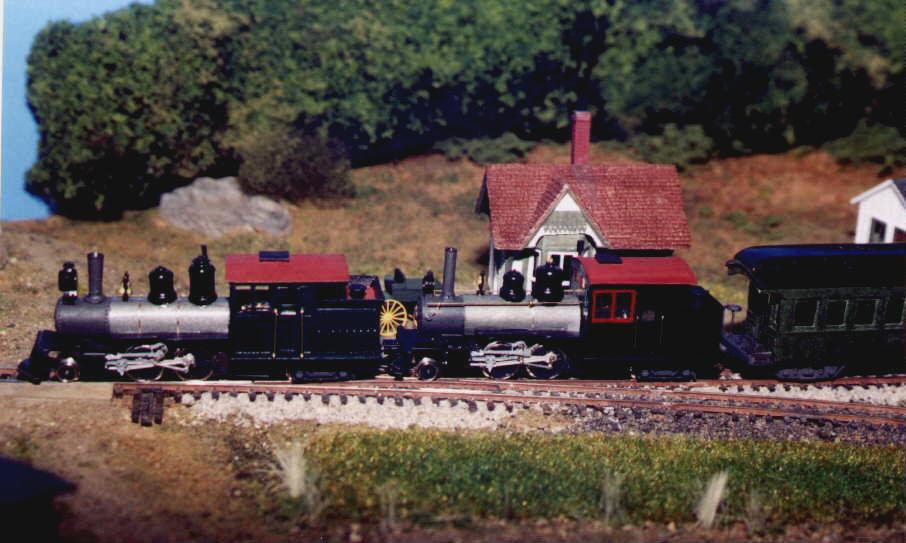New
England Narrow Gauge.
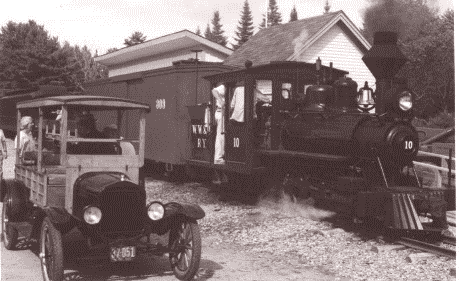
New
Updated Links
More New Links
Yet More Links
Updated links
Updated
Updated
Update
Update new link
Update
Update
Update
Update
Update
Last Update
Latest Update 07/11/2006 Fixed image links broken by editing with MS Word (Grumble, mutter).
Contents:
Joe Works and Sango HOn30 models from the 1980s
New England Narrow Gauge
Quite often people immediately think "
Billerica Bedford Massachusetts
This line was the first two footer.
It lasted less than a year, with all rail and equipment (and chief proponent
George Mansfield) going to Franklin County, Maine and the
Boston Revere Beach Massachusetts
How about a three-foot narrow gauge line that ran in
Grafton Centre Railroad.
Narrow gauge predecessor of the Grafton & Upton.
Martha's Vineyard RR (Massachusetts
Another three-foot gauge island railroad. Used a small Porter 0-6-0 tender engine.
Nantucket RR (Massachusetts
A three-foot gauge line connected the main boat landing with
hotels and other communities on the island. Used a Mason
Bogie,
West River Vermont
A three-foot gauge country shortline,
controlled for a time by the
Worcester Shrewsbury
The narrow gauge Worcester & Shrewsbury RR was opened in
July 1873 to haul passengers the 2.7 miles between
New England Industrial Narrow Gauge.
Various
Narrow Gauge Modeling.
I've been interested in narrow gauge railroads ever since Bob Hayden and Dave Frary published their series on the
Early Attempts.
The original HOn30 layout is long gone, although bits and
pieces remain (pack rat that I am). Here we see some of the original rolling
stock. The Elk River-esque Minitrains
Plymouth needs new gears to become operational (and will be cleaned up/modified
with a front transmission housing and hood top gas thank similar to the WW1 gas
engines when it is made operational). The small two wheel cars are all based on
Minitrains mine cars, following both Frary/Hayden techniques and those of E.L. Moore in a small
HOn30/TT/N scale layout he built around the same time. The four wheel box car
and caboose are rather un-convincing, especially with the single freight truck
side frame fitted over the wheels instead of pedestals. The MR&W lettering
could stand for either Moose River and Western (fairly
A couple of structures built for this layout survived, including a small water tank and a bucket coaling facility (both scratch built).
Current Module.
The module is based on scenes in Robert Jones "Two Feet
to Tidewater", but is planned to serve as a rural area on my free-lanced
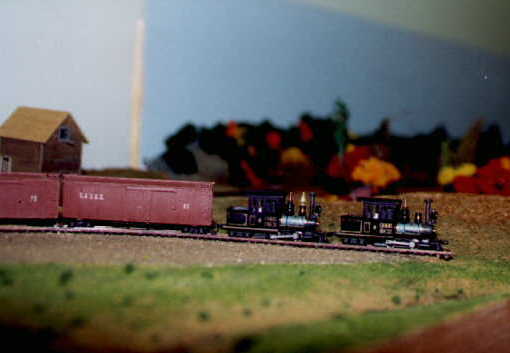
Two B&B Joe Works forneys and Polymold boxcars wait on the spur track on my module.
Jeff Schumaker's HOn30 rendition of the "Whistler" railcar pauses at the Woodland Scenics' Flagstop. Jeff says the railcar has sides and roof from an MDC Overton car and the drive from a Bachmann 'N' scale trolley.
My active rolling stock consists of two Joe Works
small forneys, a modified Joeuf
excursion (open) passenger car and a pair of Polymold
boxcars. Currently under construction or repair are the two Polymold
passenger cars, a powered boxcar and a couple of flats. Next up, the Sango Dachshund
Here is one of the Joe Works forneys showing that such engines don't have to be plain black! These are retired until I find a way to repower them.
Update!
The module has been to a couple of additional shows, as well as group
meets. It was displayed at Tom Dickey's railfan day and at the 2000 Whitman show. Scenery is
further along (but need to find a way to build trees that will survive removal
from the module and transport). The first picture shows Tom's B&SR #9
pulling a train across the module. The other two show Bob Bennet's
train on the main and my Bachmann/AHM Baldwin conversion on the side track.
|
|
|
|
Under construction also is a N Gauge Kato 2-6-4T to
HOn30 2-4-4T conversion. More when it's a bit further along. (See below)
European Prototype Models.
The next train shown is a European style freight with a Jeouf Decauville engine pulling Minitrains and scratch built cars. The inspiration for these were the Welsh narrow gauge filtered through the Thomas the Tank Engine books (which had a series on a line like the Talylyn) and some random articles in MR and Airfix magazine. These were built before the scribed and pre-cut strip styrene from Evergreen became available, so scribed sheet and strip stock had to be hand cut/carved from plain sheet. The second train is a passenger tram consisting of an Egger/Joeuf steam dummy and Liliput passenger stock. I've always liked steam dummies and wish I had one of the old Ken Kidder HO versions in my collection! As you can see, I never really settled on a single prototype (or even continent!).

HOn30 Conversions
Locomotive Conversion Ideas:
Some of these I've done or am in the process of doing, some I plan to do and others I just like (but there is only so much time and money). Most will cost between $100 - $200 dollars when finished the majority probably around the $150 or less. Note that there is one problem with the majority of these conversions (and most HOn30 steam conversions in general). Most locomotives in 30 inch gauge or less, excepting some 0-4-0, 0-6-0 and 0-4-4 types, are outside frame! The limitations are either weight (its hard to balance the greater weight of large engines on the skinny frame) or firebox size (the engine either needs a very narrow firebox between the frames or a high shallow one above them, either of which limits power on steam engines). Unless you are inclined to build your own wheel/axle extensions, counterweights and frame members this factor pretty well limits you to either very small locos or living with the inside frame drives.
Steam:
Bachmann 0-4-0 to 4-4-0: There was some discussion of this
on the Mailcar HOn30 list. The resulting engine would
be smaller than the (tiny) 2 ft.
Flieschmann 7000 : Tank Locomotive 0-4-0T: This drive might make a better basis for a small 0-4-0 switcher than the Bachmann dockside drive. The dockside wheelbase is shorter than most 0-4-0s, allowing it to rock when trying to start against a load (sometimes un-coupling). In particular, most small Porter locomotives had much longer (relative to wheel size) wheel bases. This drive with the Kennebunk Porter conversion should make a nice looking engine. I don't know what it's running qualities are, and the wheel flanges would need filing.
Kato C-11 2-6-4T: Remove the rear driver and add Chivers,
Brick Price or Portland Forney conversion to make a high-drivered
Forney. The Chivers kit gives you all the pieces; the
Price or
Here are views of a partially finished conversion. The body of the Kato C-11
was removed and replaced with a scratch built cab, tank and boiler. I could
have saved myself a lot of work by starting with one of the Chivers
forney conversions. The brass cab would have to be
kept isolated from the frame (the frame halves have opposite polarity) and a
plastic boiler is needed for the same reason. The engine is smaller than the
late forneys like SR&RL #10 and B&SR #7, but
is still a nice sized engine. The Kato drive runs beautifully out of the box
(most brass requires a bit to a lot of tweaking to run right). The wheels are
too large and too close together for any
|
|
|
|
|
|
|
|
Kato C-58
Keith Wandry had the same idea, and is in the
process of building it! He has a couple of in progress pictures on his site.
One shows the mechanism
together with a drawing of the Chivers body, the
other shows the boiler
and cab fitted to the mechanism. To see the difference in appearance,
follow the link below to Ken's Chivers
Bachmann, Tomix or MDC
Flieschmann 7095 - Class 94 Tank Locomotive 0-10-0
or 7186 - Class 50 Tender Locomotive
Internal Combustion:
LifeLike SW1200 and Ertl Mavis: Almost everyone knows about this combination. This is a quick and in-expensive way to get some motive power.
Box cab on various chassis: There are several approaches possible here. Get the best running N diesel drive you can find. Body can be made from various steel caboose shells (see Martin Fischer's beautiful HOn3 box cab made using an Athearn Santa Fe caboose shell), from two Grandt line GE box cabs or from wood. Keep in mind that while a logging speeder might be home built and look like a shack on wheels, most road power would show a bit more refinement. The Grandt box cab itself can be converted by sliding in the wheels on the axles.
Here is my conversion, based on Martin's, Gerry Hopkins' FS&K engines and Jeff Saxton's On30 Sekiu Lumber box cab. It needs a boxy radiator on the roof so it doesn't look so much like an electric. The drive is an Atlas/Kato RS-11. Windows are Grandt outfit car castings, doors are Grandt HOn3 caboose, louvers are from City Classics.
GE Hood Unit: About the simplest conversion you can do is to slide in the wheels on the Grandt HOn3 GE hood or box cab unit. I think you have to shave off some of the bearings to get the wheels in gauge. Other options include narrowing the cab and mounting on two trucks to build the Whittin Machine Works/Edaville units, or combining two kits with an N diesel to make a double ended two truck engine. Jeff Schumaker made a beautiful example of this, written up in Light Iron Digest.
Jordan Mack switcher: The Jordan 15 ton Mack switcher should lend itself to powering either with a small N power truck (like the Bachmann Plymouth) or a left over drive from one of the Grandt conversions discussed above.
SS Limited Mack switcher: This kit was metal, and a different style switcher
than the
Bachmann HO 44 tonner and 70 tonner: I've seen a Bachmann 44 tonner converted to HOn30. I'm not sure if the drive was original or replaced with a LifeLike F7 or similar. The frame was lowered and narrowed, the hood and cab were narrowed. Be sure to make the hood narrow enough for the cab door to work! Or move the door. A similar conversion should be possible with the 70 tonner. The results would be similar to Southern Pacific's 3 foot gauge GE units.
Two foot Alco: Using an N gauge PA drive and parts from HO Alco shells it should be possible to cobble up something similar to the WP&Y Alcos (either the hood units or the shovel nosed cab units). This would be a very modern narrow gauge line.
Two foot Uboat:
Streamliner: In the 1920's and 1930's these were popular on the mainline RRs. Who's to say no narrow gauge line would ever come up
with a version of the Zepher/Flying Yankee or
Roco-Baldwin Conversion.
I was inspired by a builders photo
of a Baldwin 30 inch
gauge 0-6-0T to look at Americanizing a Roco
0-6-0. Others have done this,
although I think something has to be done with the cab to remove the German
look. I knew I had a cab and domes from a damaged AHM Baldwin around (if I
could just find it!), so I scanned both the Roco engine and another
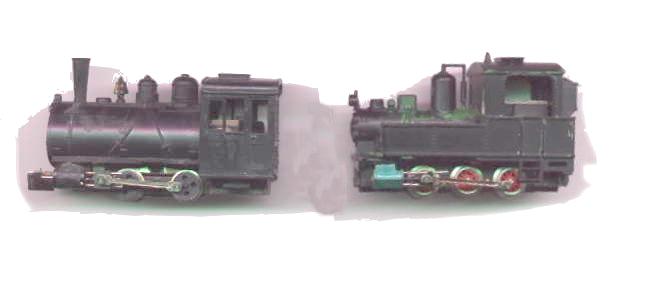
The second image is a composite showing three options for the conversion. Number 1 is the minimal conversion. The cab , stack and domes are replaced with the Minitrains Baldwin parts. I spliced on the Minitrains pilots as well, although I'll build those up for the actual conversion. Those who do not have a scrapped Minitrains shell available could make the same conversion using the Chivers Finelines Baldwin 0-4-2T kit, setting aside the saddle tank casting. The problem with this conversion is the whole engine is obviously shorter than the Grove Farms loco on which it is based, and the side tanks are both lower and shorter. The proportions are closer to those of various Porter locomotives (See below). You could scratch build a Porter cab and domes or take them from an otherwise non operable Joe Works Porter. An etched Porter cab should be available in the near future if you can wait for it.
Number 2 is the same engine with the side tanks built up to match the proportions of the prototype. This would not be hard with riveted styrene or brass overlays, but does raise the level of building above the simple replacement of parts. This might make a good conversion kit of etched/cast parts.
Number 3 is a pretty close replica, with the boiler and side tanks extended back to allow the second sand dome and match the proportions of the prototype very closely. This would be a difficult conversion because the motor gets in the way of the extended boiler. This might be fixable with a smaller can motor. The need to make the curved boiler and an extension on the frame raise the difficulty of this conversion, but it's still not scratch building.
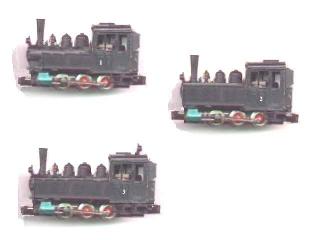
I'm not sure what a
Another option is to use this Roco engine as the
basis of a Porter. The roof line is closer (a sharper curve than the
|
Ok, I've started the Porter conversion. I decided to leave it as an 0-6-0. The photos show a start with the cab overlays in place (the windows need cutting out) and extensions of the side tanks framed but needing riveted overlays. Still needed also are some covering of the joint under the smokebox and the front and rear pilots. |
|
|
|
|
Links of Interest.
New England Narrow Gauge, prototype and model.
HOn30 Home Depot - THE source for HOn30 info.
The Flagstop New England HOn30 Module Guild home page.
Old Revere Beach Photo Album, including BRB&L photos.
Friends of the Bedford Depot
Where
Ken's Chiver's 2-6-2 in progress. On a kato drive.
PENOBSCOT BAY RAILWAY AND NAVIGATION COMPANY. (Dead Link)
Toma's Two Foot Modeling Maine HOn30, in Japanese (unfortunately, I'd love to read about building the B&B Puck!) NEW! English translations available.
Sn2 SR&RL, Gilpin Tram, and Eastern Narrow Gauge info.
Jeff Bissionette's HOn2 site Need new address
Massachusetts steam locomotives
Pleasure Island
Sugar
The Cane SIG Sugar cane RRs and modeling (mostly HOn30).
The
Godchaux Plantation Railroads
A Sugar Plantation layout. Good pictures of the Chiver's Forney. Recently added a Sango Dachshund Baldwin
Other
The 30 Inch Gauge Logging Page. Covers
some of the limited 30 inch gauge in the
A Yosemite Shortline Hopper Car in HOn30
DEER CREEK A HOn30 working logging diorama.
Narrow Gauge around the world (prototypes).
Narrow Gauge From Off The Beaten
Path - Unusual locos (including the
The Narrow Gauge book list Dead Link
Narrow Gauge Industrial RRs (Mostly European)(Moved!)
Southern (REALLY Southern) Two foot and 30 inch gauge
railroads in
Swedish Narrow Gauge museum site with some really funky critters! (in Swedish, but the pictures are neat).
History of Koppel light railway cars.
Railfan Photos at Don's Railspot (includes industrial critters and Korean 30 inch gauge).
Mauro Bottegal's Decauville and Feldbahn page. Italian and other narrow gauge and some nice HOe conversions (Dead Link).
Narrow Gauge around the world (models).
HOe Online In German.
Stefan Zickenrott's very nice HOe layout. (Dead link)
OO9 - Netherlands group Layouts and projjects in OO9 and HOe.
Frederic Delaitre home page. Narrow Gauge and subway links, and a history of Egger-Bahn and Joeuf HOe trains (in English and French).
Light Railway in small: The Egger - Bahn Another Egger-Bahn history (English, some German).(Dead link!)
Narrow gauge & Co. Narrow gauge and an illustrated history of Egger-Bahn (by year!). In French
Narrow gauge model railways in H0e (H0n30) scale - Serbian HOn30 models by Aleksandar Salatic
GUILLAUME'S MODEL RAILWAYS Dutch tram and industrial models and prototypes, in Dutch and English
A Sn2 0-4-0 modeled (very nicely!) in 9mm gauge..
Hiromi Masaki's page. Want to see HOn20 models running on code 25! rail? This is the place. (New page, still under construction.)
The world of model making - The passion of the narrow gauge railway. Mostly large scale, some great links! English and French. (Dead Link)
Railway Recollections (formerly Miracle Castings). Producer of Resin HOn30 models including new Porters, passenger cars and Gilpin Tram ore cars.
Mark Rollins Railroad Designs Including a nifty Class A Climax conversion and a EBT style speeder.
Train and Trooper Carries most lines of U.S. HOn30, and sells its own resin cars.
B&F Hobby Another great source for HOn30.
Miniatures by Eric has introduced a line of Hawaiian sugar trains in both HOn30 and On30.
Mocalova
Model Works
The New England Scene HO scale Mains 2ft structures.
Steven’s Creek Models Makers of HOn30, On30 and laser cut parts.
Portland Locomotive
Works Makes various
Banta Modelworks Makes HO and S laser cut models of Philips Station from the SR&RL.
American Model Builders Makes an HO laser cut model of Strong station.
Non-U.S. Manufacturers of HOn30 (and 009)
Peco (009)
Backwoods Miniatures (009)
Langley (love the Double-Fairlee on a Bachmann U36b chassis)
Ferro-Train European train models
Worsley Works (009) (Dead link)
The Latest Joe Works locos (in Japanese).
Reynaulds A U.S. source for Roco, Liliput and Tilig HOe (and European N mechanisms as well).
Schmalspubedarf Supplier of specialized in German and Austrian narrow gauge railways in scale 1/87.
Modellwagen
is a builder of HOe models in
This page hosted by![]()
Get your own Free Home Page
